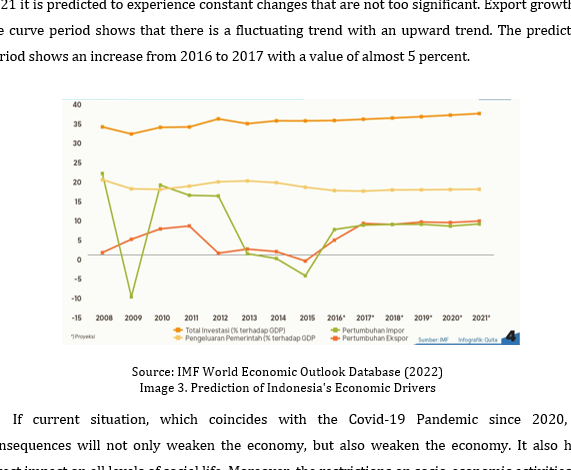Competitiveness Strategy in Facing Sustainable Economic Development on Social Economic Basis in Indonesia
DOI:
https://doi.org/10.12928/jampe.v1i2.5926Abstract
Currently, what makes one of the human economies grow is economic development, especially in the new era, development is encouraged for the environmental domain, including in the socio-economic field. This paper aims to find out how the competitiveness strategy in facing sustainable economic development on the basis of socio-economic aspects sees Indonesia's position in the context of economic recovery, one of which is the problem from the economic side, namely economic growth and the social side, namely unemployment.
References
Anglingkusumo, R., & Desthy, V. S. (2012). Proyeksi Kelas Menengah Hingga 2045. Catatan Riset Departemen Kebijakan Ekonomi dan Moneter.
Ali, M., Egbetokun, A., & Memon, M.H. (2018). Human Capital, Social Capbilities, and Economic Growth, Economiies 6. https://doi.org/10.3390/economies6010002
Alzahrani, Fawzia. (2021). The Role Social Entrepreneurship in The Process of Recovery From Disaster A Systematic Literature Review During Covid-19 Era. International Journal of Economics, Business and Management Research. Vol.5, p. (10), ISSN: 2456-7760.
Annur, C. M. (2021). Jumlah Pengangguran Capai 8,75 Juta Orang per Februari 2021. (D. J. Bayu, Ed.) Retrieved Oktober 16, 2021, from Kata Data: https://databoks.katadata.co.id
Arifin, S., Winantyo, R., & Yati, K. e. (2007). Integrasi Keuangan dan Moneter di Asia Timur Peluang dan Tantangan Bagi Indonesia. Jakarta: Elex Media Komputindo.
Asian Development Bank, A. (2011). Asia 2050: Realizing the Asian Century. Sage, Delhi: ADB.
Badan Pusat Statistik, B. (2021). Klasifikasi Pengangguran. Retrieved from Badan Pusat Statistik: https://bps.go.id.
Bapennas. (2020). Laju Pertmbuhan Ekonomi Indonesia Tahun 2018-2021. Kedeputian Bidang Pengembangan Regional https://simreg.bappenas.go.id/home/pemantauan/lpe.
Fauzi, A. (2004). Ekonomi Sumber Daya Alam dan Lingkungan, Teori dan Aplikasi. Jakarta: Gramedia Pustaka Utama.
Frankel, J. A. (2010). The Natural Resource Curse: A Survey. National Bureau of Economic Research, Working Paper No. 15836. https://doi.org/10.2139/ssrn.1565588
Haryanto, E. (2019). Penganggruan dan Krisis Ekonomi. Widyaiswara Ahli Madya Pusdiklat Keuangan Umum BPPK.
Juhro, D. S. (2018). Pembangunan Ekonomi Berkelanjutan: Tantangan dan Strategi Kebijakan. (D. S. Juhro, Performer) Jakarta.
Kuncoro, M. (2007). Ekonomika Industri Indonesia Menuju Negara Industri Baru 2030. Yogyakarta: Penerbit Andi.
Mahyiddin. (2020). Covid-19, New Normal dan Perencanaan Pembangunan di Indonesia. The Indonesian Journal of Development Planing, IV(2), pp. 240-252. https://doi.org/10.36574/jpp.v4i2.118
Milica, D. and Milica, J., (2019). Productive Employment and Working Condition as Determinant of Sustainable Economic Development in Serbia. Studies in Bussines & Economics, 14.(3). https://doi.org/10.2478/sbe-2019-0045
Murni, A. (2009). Ekonomika Makro. Bandung: PT. Refika Aditama.
Muradov, R. (2019). Unemployment and some Issues of use Human Capital Economic and Social Development . Economic and Social Development: Proceedings, pp.539-546.
Nadya, Damia, & Riza. (2020). Perkembangan Indeks Daya Saing Global: Indonesia. In D. P. Indonesai, Perkembangan Indeks Daya Saing Global Indonesia (pp. 1-16). Jakarta: Pusat Kajian Anggaran Badan Keahlian Sekertariat Jenderal DPR RI.
Peraturan Menteri Pendidikan Nasional Republik Indonesia Nomor 41 Tahun 2007 tentang Standar Proses Untuk Satuan Pendidikan Dasar dan Menengah.
Porter, M. A. (2001). Competitive Advantage Edisi Bahasa Indonesia. Jakarta: PT Indeks Kelompok Gramedia. https://doi.org/10.1002/cir.3880010112
Porter, M. E. (1990). The Competitive Advantage of Nations. (T. M. Ltd, Interviewer).
Prasetyo, P.E. & Kistanti, N.R., (2020). Human Capital Instutional economics and etrepreneurship as a driver for quality and sustainable economic growth. Entrepreneurship and Sustainable Issues. 7.4. p. 2575. https://doi.org/10.9770/jesi.2020.7.4(1)
Salim, E. (1990). Konsep Pembangunan Berkelanjutan. Jakarta.
Setiawan, R., & Setiadin, G. F. (2020). Strategi Indonesia dalam Membangkitkan Perekonomian Nasional Pasca Covid-19, Sudah Siapkah untuk Bangkit Kembali pada 2021? Retrieved from egsaugm: https://egsa.geo.ugm.ac.id
Siwu, H. F. (2018). Strategi Pertumbuhan dan Pembangunan Ekonomi Daerah. Manado: Universitas Sam Ratulangi. https://doi.org/10.35794/jpekd.16464.19.3.2017
Sukirno, S. (2008). Ekonomi Pembangunan. Yogyakarta: BPEE Yogyakarta.
Suparmoko, M. (2020). Konsep Pembangunan Berkelanjutan Dalam Perencanaan Pembangunan Nasional dan Regional. Jurnal Ekonomika dan Manajemen, 9(1), 39-50.
Sutamihardja. (2004). Perubahan Lingkungan Global. Program Studi Pengolahan Sumber Daya Alam dan Lingkungan Sekolah Pascasarjana. Bandung: IPB.
Syahrir, R. (2022). Maximing the Contribution of Mining to Sustainable Development in Indonesia. University of Exeter: Doctor of Philosophy in Mining and Minerals Engineering.
Todaro, M. P., & Smith, S. C. (2015). Economic Development (12Thed.). London, UK: Pearson Education Limited.
World Economic Forum, W. (2019). The Global Competitivness Index Report 2015-2019.

Downloads
Published
Issue
Section
License
Copyright (c) 2022 Try Citra Puspitasari Lubis Citra

This work is licensed under a Creative Commons Attribution-ShareAlike 4.0 International License.










